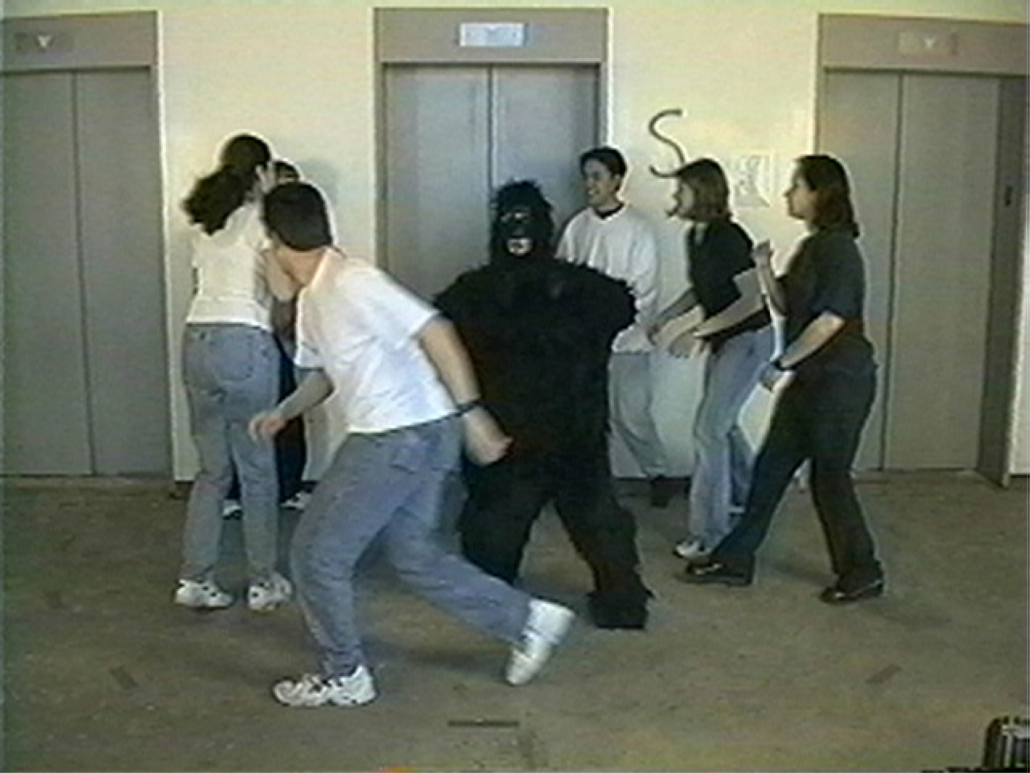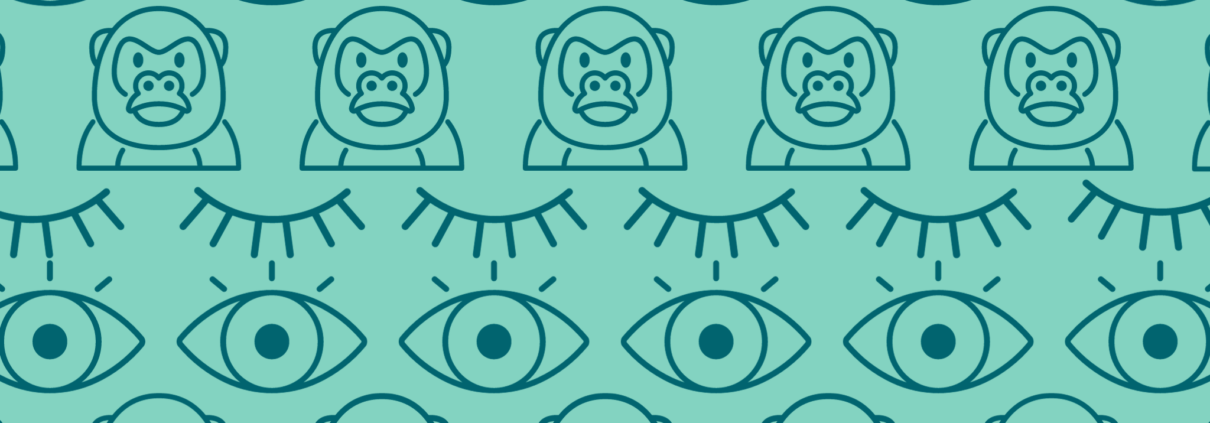The science behind inattentional blindness
The video—the now-famous video—is riveting. The “gorilla” struts in with unbelievable coolness. It’s a walk that still radiates with purpose and virality, even now, a quarter century later. Of course, the beast has no problem moving through these two groups—six people in all—now moving around one another, passing basketballs in an otherwise empty hallway.
They mean nothing to this creature. It has nothing to fear. It is the great gorilla. Or rather, as the world later came to know, the woman in the gorilla suit.
Finally, the real show begins. As the players go about their business, the gorilla stops to stand at the center. Turning its attention to us, the beast beats its chest. With that, it walks away. There’s no need to stay longer. The gorilla has shown it is the true star. Or that it was the star, at least to 50 percent of the 12 people who were watching on this particular video display.
For the other 50 percent taking part in this 1999-year study, the proud, costumed beast never existed. Instead, study participants had focused solely on the task given to them—counting how many times those in white shirts passed the basketball between them.
But how? And why?
The inability to see an important, disruptive force in this type of situation is known as “Inattentional Blindness”—a term defined by Arien Mack and Irvin Rock in their 1998 book of the same name, a year before the gorilla came on and off the stage in a study titled “Gorillas in our midst: Sustained Inattentional Blindness for Dynamic Events,” conducted by Daniel Simons and Christopher Chabris at Harvard University.
Of course, there’s no “real” blindness here. Nothing’s medically wrong with those who failed to notice the peculiar primate. Those who ignored the gorilla simply could not see it—they were blind to anything they didn’t expect, or couldn’t account for in this setting.

Origins of studies in ‘blindness’
The famous gorilla study was a replication of a 1979 study led by Urlic Neisser (summarized in this book chapter). In his version, the teams were filmed separately and partially transparent and overlapping. Here, those watching were asked after if they had seen a ghostly woman carrying an umbrella.
Following the original study, scientists had assumed results were due to unusual displays and other possible outliers. Put differently, they assumed people missed the umbrella woman because the displays were ghostly and strange.
But a gorilla? Something fully visible? Filmed with a single camera shot? Research has shown that people are more likely to have their attention drawn to stimuli that are meaningful to them (like their own name) during a selective visual attention task.
Still, it seemed unlikely that people would miss a gorilla.
“That’s actually one of the things that probably made it go viral,” said Dr. Simons, a professor of psychology at the University of Illinois, Urbana-Champaign, where he runs its Visual Cognition Laboratory. “You can be in a room with a few people when only half of them see it.
Dr. Simons continued: “We knew that people can miss things. If you make something subtle enough, nobody will see it and nobody will care. But if people miss something that that’s visible enough that people would say, ‘Oh, yeah, of course, I would see that,’ then it becomes interesting. What’s interesting is not just that people miss things, but that people are convinced that they would see it. Mismatch between what people see and what they think they’ll see is why inattentional blindness can have practical consequences.”
(For a hilarious documentary-style video about the study, click here.)
When focusing matters most
It should be a good thing: Our ability to focus on the task at hand. As Dr. Simons said, our ability to focus our attention on the things that actually matter to us while ignoring everything else is what allows us to function.
“People sometimes ask how they can train themselves to always spot the gorilla,” Dr. Simons said. “You can’t, though—and even if you could, you wouldn’t want to. We need to be able to focus and avoid constant distraction.”
Sometimes this ability to focus has costs. The gorilla study showed that inattentional blindness can strike at any time. A later study, titled, “Did you see the unicycling clown? Inattentional blindness while walking and talking on a cell phone,” led to the same finding.
“If people are convinced that they’re going to notice when something unexpected happens, then they’re not going to take the precautions that they might need to,” said Dr. Simons. As an example, he said that when you’re driving and talking on the phone, if you’re convinced that you’d automatically notice if something important happened, you might take unnecessary risks like texting and talking on the phone.
“Even if your eyes are on the road, that doesn’t mean you’re necessarily going to see everything,” Dr. Simons said. “Most of the time, inattentional blindness doesn’t have huge consequences [but] every now and then it does—especially when we’re doing things that our visual system wasn’t really designed to do.”
Dr. Simons noted that traveling in a vehicle at 60 mph is one such activity. At this speed, he said, even a one- or two-second delay due to blindness can be huge. It can be the difference between having a fatal accident and avoiding one.
“I think that’s where intuition causes the biggest problems,” he says. “The most common kind of crash between a car and a motorcycle is the ‘look-but-fail-to see.’ That has all the hallmarks of inattentional blindness: Somebody’s turned left in front of an oncoming motorcycle and claims never to have seen them.”
That’s not to say that those experiencing inattentional blindness miss everything. Dr. Arien Mack, co-author of the “Inattentional Blindness” book and the Alfred and Monette Marrow Professor of Psychology at The New School for Social Research in New York City, said there is evidence (in this paper, for instance) of an unknown awareness from which we can build.
“While you are not conscious that you’ve seen anything, there is evidence that in fact the thing you did not see was processed below the level of consciousness in the brain,” Dr. Mack said. “If it’s a word [someone] didn’t see, for example, and you give them a word stem in which that word is a possible completion—and maybe an unlikely completion—they will more likely complete the word stem with the word that was there, even though they didn’t consciously see it.”
Evolution of blindness
The stakes for inattentional blindness have only grown since the gorilla came into our lives (or didn’t) in the late 1990s. The clunky cellphones handed out by consulting firms and dotcom 1.0 startups were just coming into widespread use. AOL—and a home-base landline—controlled our access to the internet. Our lives, however crazed, remained siloed.
Chabris and Simons chronicled these changes in their 2010 book, “The Invisible Gorilla.” Simons also speaks freely about this evolution. His perspective: Technological advancements changed everything.
“We have good intuitions about some things and not about others,” Dr. Simons said. “You know you can’t chew gum and whistle and talk at the same time. They use your mouth in conflicting ways. We don’t realize that the kind of visual attention and attention to a conversation also use the same sorts of resources in the same sorts of ways. So, we might think, ‘Oh, I can talk on the phone while I’m driving just fine. But we don’t realize we’re impaired because we don’t realize [these activities] are using the same cognitive resources.”
What Dr. Simons is really saying: Becoming aware that you can miss something as obvious as a person in a gorilla suit is impactful in that it makes you think about how much else you might be missing. Once you realize that you won’t automatically notice everything important, then you can take steps to think about how you’re using up the limited attention you have.”
The study of inattentional blindness has undergone real refinement over the decades. Researchers like Dr. Simons have moved studies away from videos to more computer-based analogs. This has allowed for the study of the timelines—when the disruptor showing up has an effect—and similarities to the objects already on the screen.
What’s next
Dr. Simons and his colleagues have also drilled down to this key question: Is there anything that might predict those who will notice that rough beast who walks onto the screen and those who continue to count the basketballs? Kind of like a biomarker, only for how we see the world.
So far, researchers have not found stable, individual differences that predict noticing.
“When we’ve looked, we haven’t found much evidence for differences between people who do and don’t notice unexpected objects,” Dr. Simons said. “At some level, that makes sense given that people aren’t actively looking for things that they don’t expect. At some level, who notices and who doesn’t might just be a matter of chance rather than a stable ability to notice unexpected things.”
Perhaps, said Dr. Simons, the lack of identifying characteristics for those who experience inattentional blindness is a good thing.
“We’re all subject to the same limitations,” he said. “Even if people vary a little bit in how well they can focus attention. That doesn’t really make a huge difference for the detection of unexpected things.”
Of course, this also raises the value and warrants mention of the fallibility of eyewitness testimony. Our minds are not tape or video recorders encoding every detail of our experience without fail; our brains and minds are interpreting our experience with “filters” for personal and emotional salience of that information. Thus, eyewitness testimony is generally considered to be subjective at best.
The reality is that our minds can miss critical details even when they might be glaringly obvious to others. If we are paying attention to something that matters to our brain, is that something supporting or refuting someone’s innocence or guilt erroneously or accurately? And how will our experience in that moment impact our connection to what we perceive to be the truth?
These are complicated questions with complicated answers. They’re worth consideration, with or without a gorilla in the room.
This essay has been factchecked by members of NAN’s Publications Committee. For more about that process, click here.
Body photo provided by Dr. Daniel Simons; Simons, D. J., & Chabris, C. F. (1999). Gorillas in our midst: Sustained inattentional blindness for dynamic events. Perception, 28, 1059-1074.









